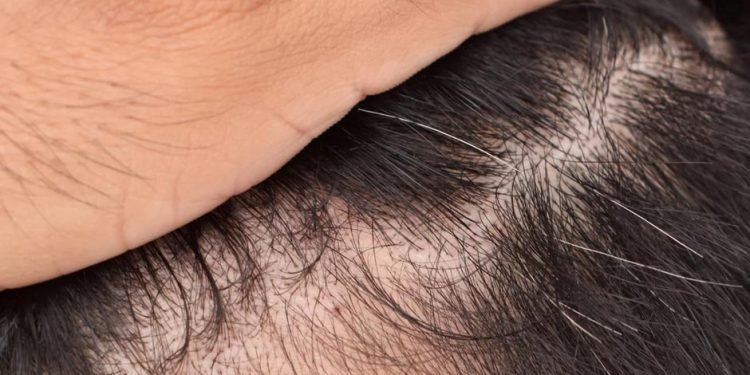Numerous individuals face the issue of hair loss, but fortunately, many treatment alternatives exist to address this widespread concern.
It can make them feel less confident and happy about their appearance.
One important thing that causes hair loss is a hormone called dihydrotestosterone, or DHT.
The hair loss caused by excessive DHT can be reduced by taking some DHT blocker medicines.
In this article, we will learn about DHT blockers that can help with hair loss.
We will see how and how well they work and some important things to consider when using them.
Understanding DHT’s influence on hair loss
One of the basic factors contributing to hair loss is a hormone called Dihydrotestosterone (DHT).
DHT significantly impacts our hair follicles, causing them to shrink gradually over time.
It attaches to androgen receptors in hair follicles, starting a process called miniaturization.
DHT attaches to hair follicles and shrinks them, leading to Male Pattern Baldness and several types of hair loss in women.
Hair loss can become visible on the scalp within three months and may lead to total hair loss in one to three years if left untreated.
Some treatments, such as Finasteride, can inhibit the conversion of Testosterone to DHT.
Still, they are not approved or safe for everyone.
By effectively reducing DHT levels, we can potentially halt or slow down the progression of hair loss.
Some studies have compared the effectiveness of Dutasteride vs Finasteride for reducing DHT.
What are DHT blockers
DHT blockers are drugs and substances that help reduce the amount of DHT in the body.
These medicines prevent the enzyme 5-alpha reductase from turning Testosterone into Dihydrotestosterone (DHT).
DHT, derived from Testosterone, plays an important part in Male Pattern Baldness and the growth of the prostate in males.
By doing so, the inhibitors promote healthy hair follicles and encourage hair growth.
There are also natural DHT blockers such as saw palmetto, stinging nettle, pumpkin seed oil, and green tea.
These foods contain compounds that can help reduce DHT levels in the body.
Different types of DHT blockers
Within the realm of DHT blockers, numerous options exist, each with distinct characteristics.
One popular choice is Finasteride, often recognized as Propecia.
Finasteride selectively inhibits the Type II variant of 5-alpha-reductase.
Another alternative for reducing DHT levels is Dutasteride, marketed as Avodart.
Dutasteride salt inhibits both Type I and Type II forms of the enzyme.
This results in a more comprehensive reduction in DHT levels.
These medications stop DHT production to improve hair follicles and promote hair regrowth.
It’s crucial to note that the choice between Dutasteride vs Finasteride should be made in consultation with your doctor.
Effectiveness and key considerations
There are different studies that have indicated that using DHT inhibitors is a successful approach to dealing with hair loss.
DHT blockers have helped in maintaining healthy hair follicles and lead to thicker and fuller hair.
Male/Female Pattern Baldness, also known as Androgenetic Alopecia, can be treated using these medicines.
Hair loss can be stopped, and hair thickness can be improved by using DHT inhibitors.
DHT blockers must be used as long-term treatments.
Discontinuing these medicines may lead to a reversal of the benefits that you have achieved.
To sustain the effects, it’s essential to stick to the recommended dosage and finish the treatment as directed.
It’s important to know that individual reactions may vary, and achieving visible improvements may need consistent effort over time.
Potential side effects
Like any medication, DHT blockers come with considerations and potential side effects.
This is where knowing the difference between Dutasteride vs Finasteride is necessary.
It will help you know which one will be suitable for your body type.
Some individuals have reported side effects like sexual dysfunction, such as erectile dysfunction and reduced libido.
These side effects are reversible and often subside upon discontinuation of the medication.
Seeking guidance from your doctor is advisable to discuss potential risks and benefits tailored to your specific circumstances.
Exploring combination approaches
In severe cases of hair loss, combining DHT blockers with other hair loss treatments helps in promoting faster hair growth.
DHT blockers are generally combined with topical Minoxidil or low-level laser therapy.
When used in combination with topical Minoxidil known as Rogaine, it can provide dual action.
Minoxidil can directly stimulate hair growth, and DHT blockers can help in inhibiting the hormone responsible for miniaturization.
This may yield more comprehensive and synergistic outcomes.
DHT blockers can also be used in combination with various nutritional supplements such as biotin, vitamins, and minerals (zinc and iron).
When used in combination, these supplements provide additional nourishment to the hair follicles and promote hair growth.
These combined approaches target various aspects of hair loss, addressing hormonal factors while directly stimulating hair growth.
Conclusion
DHT blockers play a vital role in managing hair loss by effectively reducing DHT levels.
These levels contribute to the miniaturization of hair follicles.
Finasteride and Dutasteride are the two best options that have demonstrated efficacy in slowing hair loss progression.
These medications also helped in promoting hair regrowth.
However, the effectiveness and side effects of both medicines may vary per the individual.
Consult with your doctor to determine the most suitable treatment approach.
Remember, achieving optimal results often involves a holistic approach that embraces multiple facets of hair health.












